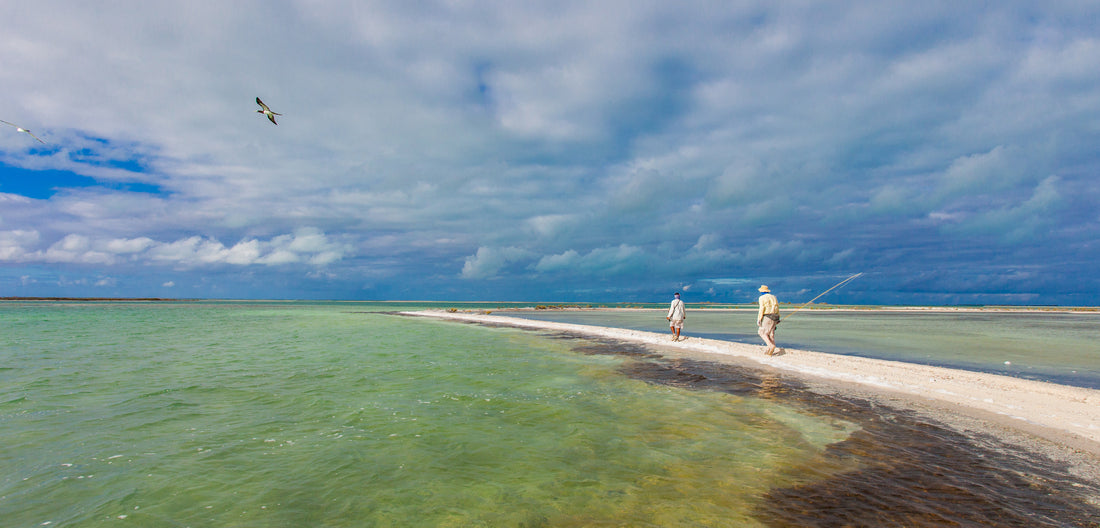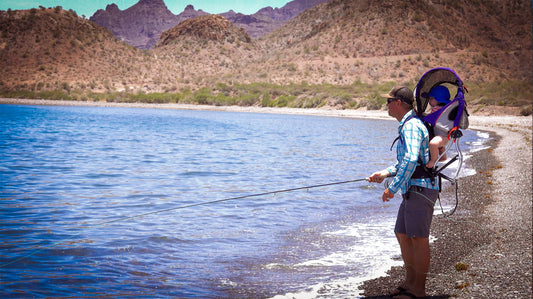Words By Brian Gies, Co-Founder, Fly Water Travel
Had Swedish naturalist Peter Forsskal had the good fortune of being an experienced saltwater fly angler, he likely would have chuckled at the clever double-meaning of his standing taxonomic identification of the first giant trevally, Caranx Iglobilis. The year was 1775 and Forsskal was in the Red Sea between Saudi Arabia and Yemen. While the Caranx genus of trevally was obvious to him, the rest of the package was so mysterious and foreign that he named the species Ignobilis to denote its "obscure and unknown" attributes. The humor in this today is that the current definition of ‘ignoble’ typically reads "not honorable in character or purpose, degenerate, mean or savage".
For those of us that have had the good fortune to chase these ferocious fish in their element, the current definition could not be more accurate. Giant trevally are the undisputed apex predator of the flats; superbly-conditioned, high-performance thugs that sometimes top 170 pounds and instill constant terror within all members of the food chain beneath them. Simply put, they are the meanest, hardest-fighting fish one could ever hope to tangle with on a 12-weight.
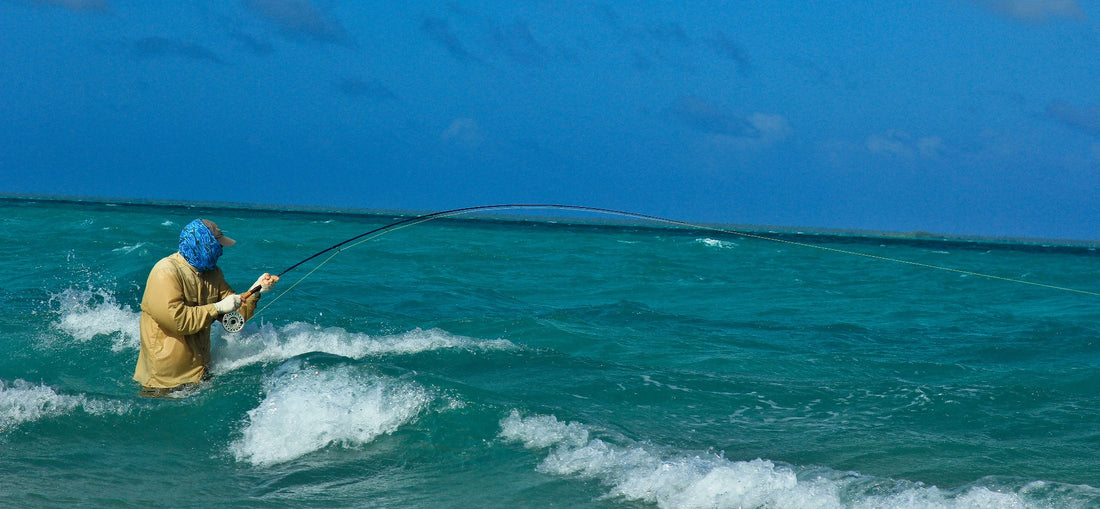
Less than a minute into hooking my first GT, I panicked. My backing was disappearing faster than I had ever imagined possible and for the first time in my life, I was fairly certain that I was going to lose everything. So, I did what seemed logical: I reefed back on my 12-weight as hard as I could, so hard that I snapped it clean in half. I am not sure what was said at the time, but I am sure my mother would not have been proud. That first encounter was nearly 20 years ago and almost every year since, I have made a trip or two to some equatorial destination with the hopes of recreating encounters of that magnitude. Truth be told, these trips have produced a multitude of opportunities, the majority of which have not ended happily. However, through a combination of learning, good luck, and proper preparation, there have been some real victories. I vividly remember one particular encounter on the flats of Christmas Island about fifteen years ago where everything really came together.
Imagine it being high noon, the trade winds are blowing soft and steady, and the equatorial sun is brilliant, warm and bright. I am in my favorite flats shirt, Buff snug around my neck, and walking an immaculate flat by myself. In my hand is my favorite bonefish rod, the well-worn one that has been everywhere with me, and tucked by my side is my trevally setup. It had been a good morning and I had just released another chunky bonefish. I’m feeling pleased with myself and the simple joys of bonefishing. I re-check my fly, strip off 25 feet of line, coil it in my hand, and am about to start walking when I see a dark mass moving slowly down the edge of the flat. I question myself and instinctively scan the flats to see if I can locate any other dots of color on the horizon. I look back at the approaching fish and realize that my heart is racing. It is the opportunity I have been waiting and preparing for, but as usual, I feel unready for the event.
Hurriedly, I reel in my bonefish setup and make the awkward transition to the GT outfit. As multiple dark shapes close to within 40 yards, I can tell there are three fish, all big but one is truly huge. They are now well onto the flat with their backs bulging out of the shallow water. Their casual pace tells me they are the undisputed kings of the flats. Instincts take over and I am in the stalking crouch, pulling line off the tightly-cranked drag. As they come within 60 feet, I make one false cast, then another, and the big fly hisses out, landing 15 feet in front of, and just beyond the pack. Immediately they stiffen and rise in the water column and, as if in anticipation of an event, time momentarily grinds to a halt. When I make my first strip everything accelerates into a blur as all three fish rush the offering. There is commotion and then tension. While I would like to tell you about a textbook strip-strike and hook-set, it was really just mayhem as I hung on for dear life. Sometime during the battle, with my backing still disappearing into the blue depths beyond the edge of the flat, my companions showed up. After several blistering runs and a few close calls with my fly line and a nearby coral head, I was able to bring the rock-hard beast, with its huge shoulders, angry eye and savage jaw, into the shallows. My close friend and guide Biita took a hold of the beast’s spiny wrist and we all exhaled a collective sigh of victory and relief.
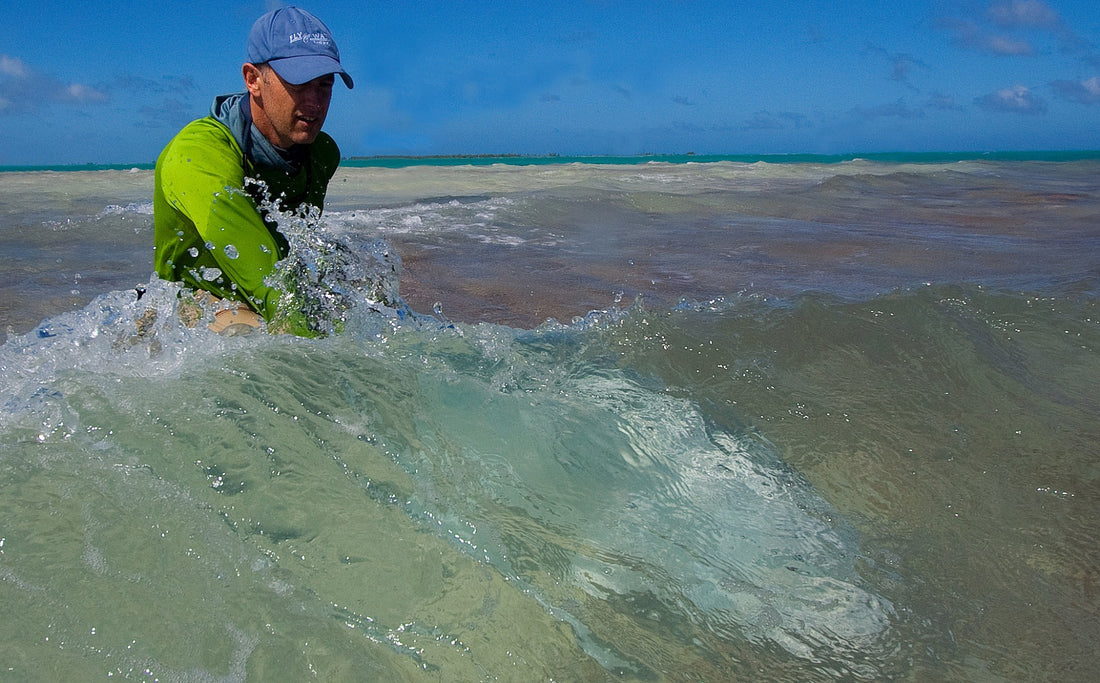
Ways to Hunt Them
There are many tactics that can be employed to target giant trevally. Unquestionably, my favorite strategy is to search for them while wading the flats. Over the past twenty years of fishing Christmas Island, the Seychelles and Mauritius I’ve learned that giant trevally are often encountered while bonefishing. It’s not uncommon to be happily throwing flies at bonefish in skinny water and all of a sudden, see a 60-pound tank terrorizing a school of mullet with a full 12 inches of its back out of the water. In this scenario, my advice is to concentrate on the edges of the flats adjacent to deep water, while also being mindful of opportune points where a fish might enter or exit the flat. For those interested in experiencing the ultimate encounter in shallow water, this is the name of the game.
Another worthy tactic that is often employed at Alphonse and Farquhar in Seychelles is to slowly cruise the flats scanning for large sharks and rays. If you spot them, be sure to get close enough, so you can see if there is a GT shadowing them. In many cases, there will be at least one, or sometimes several slowly cruising behind them. It’s not exactly clear why they do this, but the theory is that GT use these fish as cover while they prowl the flats. In these situations, anglers will either cast at the fish from a moving boat or if the water is shallow enough, the guide may move the boat into position and have the angler ease into the water to make the cast.
The third, exciting tactic is to employ a large spinning rod with a hook-less plug and attempt to tease the fish to the surface off a reef, up from a deep cut or out of coral head. Most often this will take place on the outside of the break zone, on the edge of the bluewater and flats. This is a team effort where the boat driver keeps the boat in position and an angler or guide casts the plug into the reef and retrieves it back as fast as they can. The other angler stands ready in the bow of the boat with a sturdy 12-weight and a streamer or large popper. When the plug is being retrieved it is not uncommon to have multiple fish charging after the teaser. The goal of the angler on the spinning rod is to keep the teaser away from the fish (this is not as easy as you may think) so it chases it all the way in. When the fish are within casting distance the plug must be yanked clear of the water and the fly must be dropped in at the same moment (again, not as easy as it sounds).
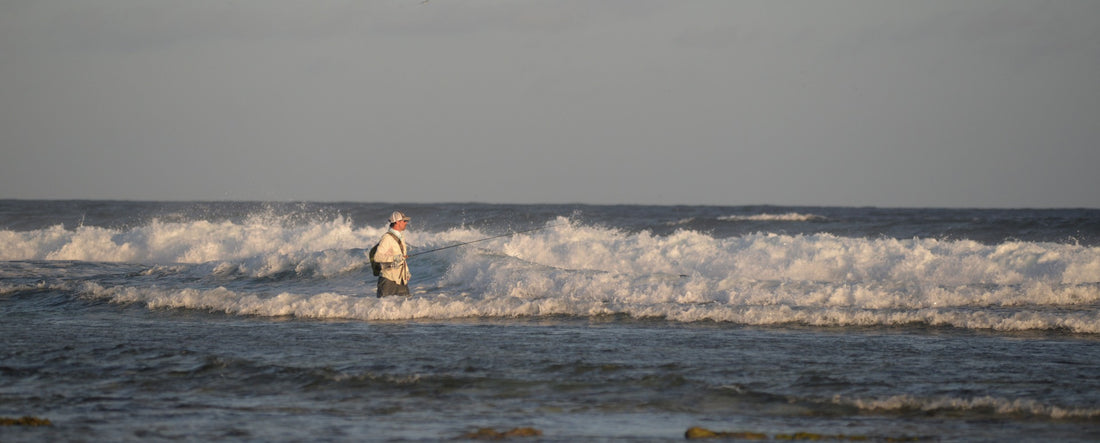
Wading On Your Own
When fishing on your own, having a speedy way to access your GT outfit and get your fly airborne is imperative. We prefer to rig the bigger rod with the fighting butt tucked into a Quikshot Rod Holder. In this way, anglers can fish bonefish while always keeping a keen eye out for GT. When a GT shows itself, switch out the 8-weight for your 12-weight and quickly get into position to get a fly in front of the fish. I highly recommend practicing it a few times because it doesn’t always work smoothly while under pressure. I will be the first to admit that, more often than not, my bonefish rod ends up lying on the flats somewhere because I am too focused on the larger fish to actually get it strapped back onto my pack. To date I have always been able to go back and find it after the GT event was over. However, on two separate occasions at Christmas Island, it took a considerable amount of time because when I was off chasing down the GT, a bonefish came by, picked up my fly and hooked itself! The enterprising bonefish then proceeded to drag my whole outfit to a completely new location.
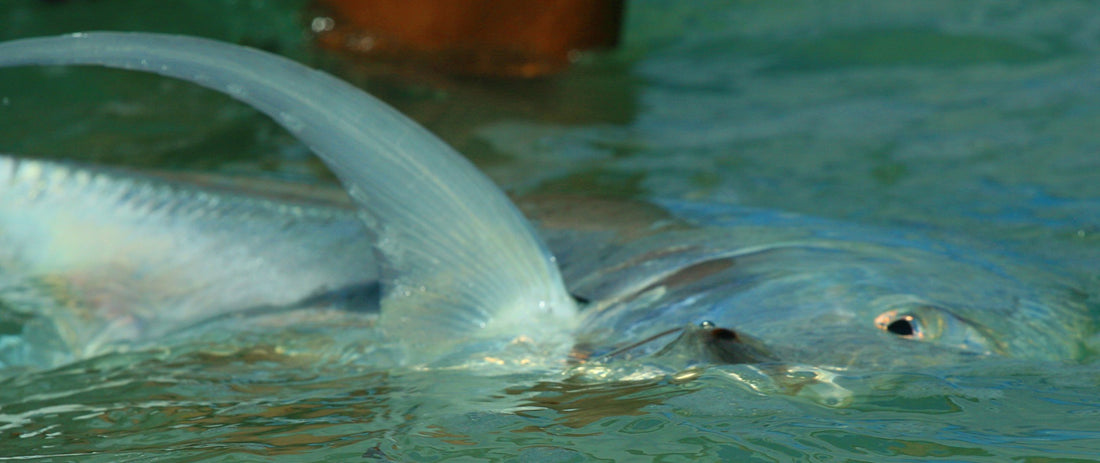
Casting, Stripping, Fighting
When casting to a fish of this nature, the presentation is critical. The worst presentation is to have the fish following the tail of the fly as it swims towards you, while the best scenario is to have the fly suddenly cross in front of the fish and to instantly entice the fish to attack. In an ideal situation, the fly will land just beyond and to the side of the fish so you can pull the fly across its line of vision. When done correctly this will trigger its killer instinct and initiate a sudden charge on the fly where the fish grabs the fly before your second or third strip. When you get a follow - as opposed to a charge or a missed grab - it is very important to strip as fast as you can and to never give up. I have had fish follow the fly all the way to our rod tips and then at the last instant grab both the fly and the rod tip! When a fish is hooked, it will not waste much time before blistering off for the nearest coral head or deep water.
Legendary angler Jake Jordon and the guides from South Africa have taught me that the best way to handle this is to point the rod directly at the fish (with the reel’s drag fully cranked down) with virtually no bend in the rod. This allows the reel to do its job and puts the maximum amount of pressure on the fish. At this point, it is a battle of wills. If you give this fish an inch, they will take you a mile, so keep the rod straight and take in line as fast and steady as you can. If done correctly, you can land even the biggest brutes in under twenty minutes. If you fight the fish with a high bent rod and moderate drag pressure, you will be in for a long and grueling interaction.
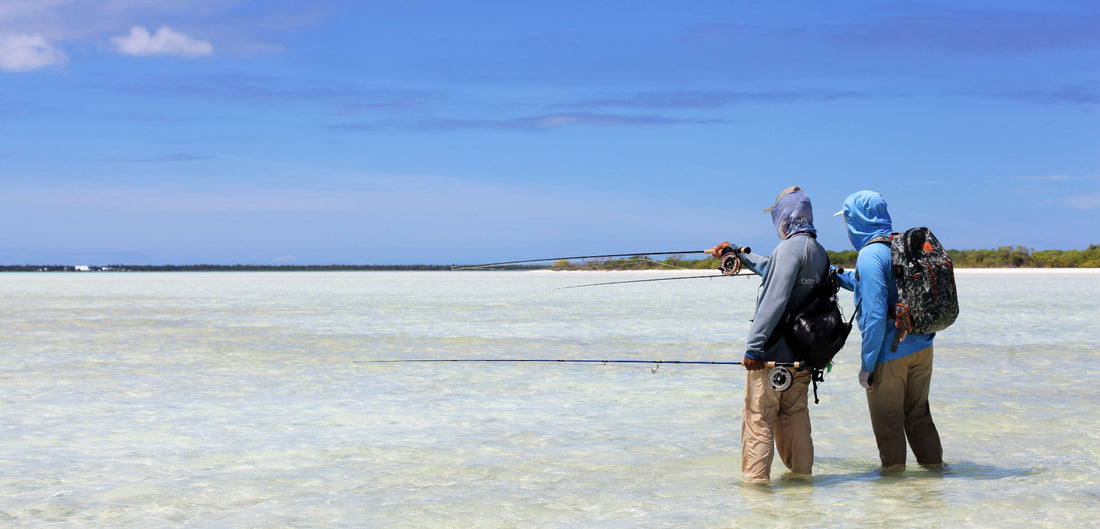
Gearing Up
As you might guess, a fish with this type of speed and power will expose any flaw in your setup. Even when you are using the best rods, reels, and lines available, a fair bit of luck is involved in landing the big ones. 11 or 12-weight rods, lines designed to cast large flies at long distances, and reels with a ton of stopping power are a must.
The truth is that every piece of gear you bring to this fight will determine your success or failure. This includes everything from the pack you’re wearing, to the accessories you use. Of course, it starts with making sure that your rods and reels arrive at their destination in full working order. For international travel, our go-to is the Dakota Carry-On Rod & Reel Case. The molded bottom and adjustable interior dividers afford plenty of space for a full quiver of rods and reels. On the water, the ideal setup for stalking these giants is a pack system paired with add-ons and accessories that will keep everything you need within one quick reach. Bombproof, TPU coated nylon and a fully waterproof TIZIP zipper on the Thunderhead Submersible Backpack allow you to withstand an afternoon shower on the flats of Christmas Island or head-high breakers on the beaches of Oman.
When it comes to accessories, the name of the game is speed. When a GT moves into your line of sight, you’ll typically have only a few moments to get into position and make a cast. The Quickshot Rod Holder will keep your 12-weight secure, and deployable at a moment’s notice. In the event that a section of your leader gets torn up on a coral head, it always helps to have a loaded Headgate Tippet Holder XL with plenty of 80-100lb fluorocarbon.


For more information on Christmas Island, the Seychelles, and other destinations where you can chase giant trevally, contact Brian at Fly Water Travel. Brian can be reached at brian@flywatertravel.com or by calling (800) 552-2729.

